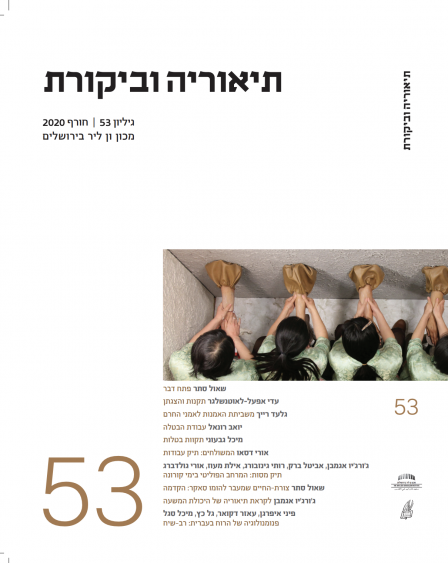מ"שביתת האמנות" ל"אמני החרם": סירוב, הימנעות ומחוות של אי-השתתפות באמנות העכשווית
גלעד רייך
מאמר זה מתבונן בתצורות שונות של סירוב ובוחן אותן כפרקטיקה הקושרת בין האמנותי לפוליטי מפרספקטיבה היסטורית ותיאורטית. כיצד הפכו חרם, הימנעות ומחוות אחרות של אי-ההשתתפות לביטויים המובהקים ביותר של אמנות פוליטית כיום? מאילו מסורות שואבים אמנים ואמניות את אופני הסירוב העכשוויים? וכיצד אסטרטגיות פעולה אלו קשורות לשינויים רחבים יותר המתרחשים בשדה הפוליטי ובעולם העבודה? המאמר מנסה לפלס דרך בין שתי עמדות רווחות בשיח העכשווי: זו המקדשת את ההפרדה בין אמנות לאקטיביזם, שמשמרת את הטוהר המדומיין של כל אחד מהשדות, וזו המקדשת "אמנות פוליטית", שלדידה כל נקיטת עמדה אופוזיציונית מול המציאות היא פעולה ביקורתית. לשם כך מוצגים במאמר שני מודלים של סירוב בשדה האמנות שהתפתחו בסוף שנות השישים של המאה העשרים: שביתת האמנות של קואליציית עובדי האמנות, ו"השביתה הכללית" אך האינדיווידואלית שיזמה האמנית לי לוזאנו. מודלים אלו נקשרים למהלכים בעולם האמנות העכשווית ומוצבים מול מפנים שמאפיינים את פרקטיקת האמנות בעשורים האחרונים, ובראשם המפנה החברתי באמנות ודעיכתן של קטגוריות פוליטיות מסורתיות כמו ארגון עובדים. מתוך התמקדות בקמפיין המתוקשר של קבוצת Decolonize This Place, שהוביל להתפטרותו של וורן ל' קנדרס ממועצת המנהלים של מוזיאון הוויטני בניו יורק בשנת 2019, המאמר מצביע על פוטנציאל הביקורת וגם על המגבלות של כל אחד מהמודלים, ובוחן אותם לאור צמיחתה של סובייקטיביות ניאו-ליברלית.
תקציר בעברית של המאמר


